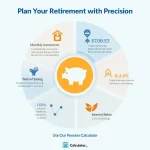Retirement Goals Calculator
Is this tool helpful?
How to use the tool
- Current Age – type your present age in years. Example: 28 or 47
- Retirement Age – enter the age you plan to stop full-time work. Example: 60 or 70
- Annual Retirement Expenses (USD) – estimate future yearly spending. Example: 72 000 or 48 500
- Annual Retirement Income (USD) – add expected pension, Social Security or rental income. Example: 26 000 or 38 000
- Inflation Rate (%) – choose a realistic long-term rate. Example: 2.8 % or 3.1 %
- Calculate – press the button; the tool shows your inflation-adjusted annual gap.
Formula used
The calculator applies the gap-with-inflation equation:
$$ A = (E – I)\times(1 + r)^{n} $$
- A – annual amount you must cover in retirement
- E – estimated annual expenses
- I – expected annual income
- r – inflation rate (decimal)
- n – years until retirement
Example calculation
Inputs: age 35, retire 60, expenses 70 000, income 25 000, inflation 3 %.
Steps:
- Gap today: 70 000 − 25 000 = 45 000
- Years until retirement: 60 − 35 = 25
- Inflation factor: (1 + 0.03)^{25} ≈ 2.094
- Needed in first retirement year: 45 000 × 2.094 ≈ 94 230 USD
Quick-Facts
- Average retiree household spends 52 141 USD yearly (BLS Consumer Expenditure Survey 2022).
- Long-term U.S. inflation averages 3.2 % (U.S. Inflation Calculator, 2023).
- Full Social Security retirement age is 67 for those born 1960+ (SSA.gov).
- 401(k) employee contribution limit: 23 000 USD for 2024 (IRS Notice 2023-75).
- Financial planners target ~80 % income replacement in retirement (Center for Retirement Research, 2021).
FAQ
What does the calculator measure?
It estimates the annual shortfall between your expected expenses and guaranteed income, then adjusts that gap for inflation until your retirement start date (BLS, 2022).
Which inflation rate should I enter?
Use a historical average—3 % aligns with the U.S. 30-year mean (Federal Reserve Economic Data, 2023). Adjust higher if you expect faster price growth.
How accurate is the estimate?
The output is as reliable as your inputs; unexpected health costs or market swings can change outcomes. “Projections are planning tools, not guarantees” (FINRA Investor Education, 2023).
How can I reduce an income gap?
Increase savings, delay retirement, lower spending, or add income streams such as part-time work or annuities (AARP Retirement Guide, 2023).
Does the tool account for investment returns?
No. It focuses on inflation. To include portfolio growth, run a separate analysis with expected real return assumptions (Morningstar Methodology, 2023).
Can I run multiple scenarios?
Yes. Change one variable—like retiring at 62 versus 68—to see how the required annual amount shifts. Scenario planning helps prioritize trade-offs (Vanguard Research, 2022).
What is a safe withdrawal rate?
Financial advisors often cite 4 % of initial portfolio value, adjusted for inflation (Bengen, 1994). Review annually against market conditions.
Why adjust for inflation?
Inflation erodes purchasing power; $1 today buys only $0.56 of 1990 goods (BLS CPI Inflation Calculator, 2023). Adjusting keeps your future budget realistic.
Important Disclaimer
The calculations, results, and content provided by our tools are not guaranteed to be accurate, complete, or reliable. Users are responsible for verifying and interpreting the results. Our content and tools may contain errors, biases, or inconsistencies. We reserve the right to save inputs and outputs from our tools for the purposes of error debugging, bias identification, and performance improvement. External companies providing AI models used in our tools may also save and process data in accordance with their own policies. By using our tools, you consent to this data collection and processing. We reserve the right to limit the usage of our tools based on current usability factors. By using our tools, you acknowledge that you have read, understood, and agreed to this disclaimer. You accept the inherent risks and limitations associated with the use of our tools and services.







